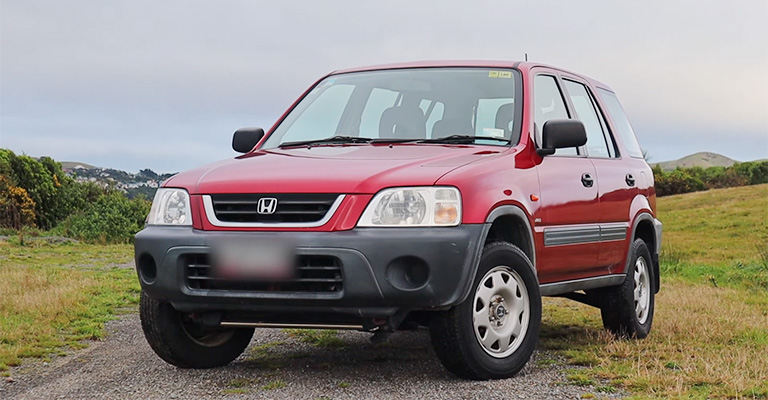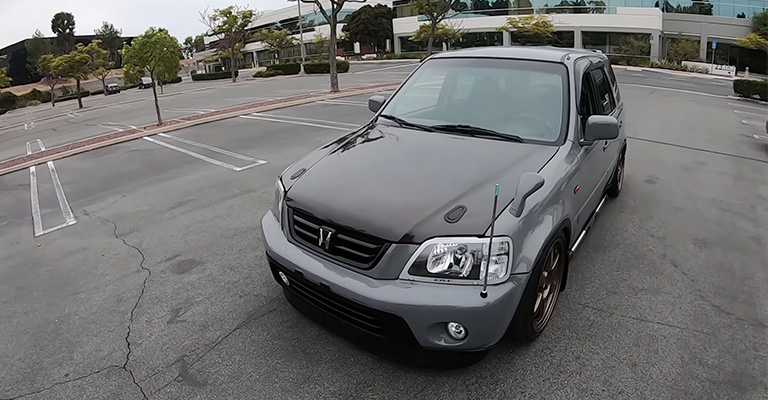The 2000 Honda CR-V is a compact SUV that offers practicality, reliability, and versatility.
Known for its fuel efficiency and spacious interior, the CR-V is a popular choice among individuals and families seeking a comfortable and capable vehicle.
With its 2.0L gas engine and front-wheel drive, the CR-V strikes a balance between power and efficiency, achieving an EPA-estimated fuel economy of 22 mpg in the city and 25 mpg on the highway.
Whether you’re navigating through urban streets or embarking on a road trip, the CR-V provides a smooth and enjoyable driving experience. Its 2WD Sport Utility body style, along with its compact dimensions, makes it easy to maneuver in various driving conditions.
Inside, the CR-V offers ample passenger space and cargo capacity, making it ideal for both daily commutes and weekend getaways.
Safety features such as driver and front passenger airbags, childproof rear door locks, and three-point seat belts contribute to the overall peace of mind while on the road.
With a solid reputation for reliability and a comprehensive warranty, the 2000 Honda CR-V is a dependable choice for those in search of a practical and well-rounded SUV.

Key Specifications of the 2000 Honda CR-V
- Engine: Gas I4, 2.0L.
- Transmission: 4-speed electronically-controlled automatic transmission w/OD, Grade Logic Control System. . .
- Drivetrain: Front Wheel Drive.
- EPA Fuel Economy Est – City: 22 mpg.
- EPA Fuel Economy Est – Hwy: 25 mpg.
- Passenger Capacity: 5.
- Body Style: Sport Utility.
- Curb Weight: 3126 lbs.
- Cargo Volume to Seat 1: 67.2 ft³.
- Warranty: Basic – 3 years/36,000 miles, Drivetrain – 3 years/36,000 miles, Corrosion – 5 years/unlimited miles.
The Good
- Fuel Efficiency: With an EPA-estimated fuel economy of 22 mpg in the city and 25 mpg on the highway, the 2000 Honda CR-V is known for its excellent gas mileage, making it a cost-effective choice for daily commuting and long drives.
- Spacious Interior: The CR-V offers a roomy cabin with a passenger volume of 98.0 ft³, providing ample space for both occupants and cargo. The versatile seating configurations and generous cargo capacity make it convenient for hauling various items.
- Reliability: Honda is renowned for its reliability, and the CR-V upholds that reputation. The 2000 model comes with a solid build quality and a proven track record of durability, ensuring a dependable and long-lasting vehicle ownership experience.
- Safety Features: The CR-V is equipped with important safety features such as driver and front passenger airbags, childproof rear door locks, and three-point seat belts. These features contribute to the overall safety of occupants, giving peace of mind on the road.
The Bad
- Outdated Transmission: The 2000 Honda CR-V is equipped with a 4-speed automatic transmission, which may feel less responsive and less efficient compared to newer vehicles with more advanced transmission technologies.
- Limited Engine Power: While the CR-V provides adequate power for daily driving, some drivers may find the 2.0L engine underwhelming in terms of acceleration and performance, particularly when fully loaded or when driving on steep inclines.
Improvements Compared to Previous Honda Models
Compared to previous Honda models in similar segments, the 2000 Honda CR-V introduced several notable improvements:. . .
- Interior Space: The 2000 CR-V offered increased passenger volume and cargo capacity compared to its predecessors. It provided a more spacious and versatile interior, making it more practical for families and those who require ample cargo-carrying capability.
- Improved Handling and Comfort: The CR-V featured an updated suspension system, resulting in improved handling and a smoother ride quality. This enhancement contributed to enhanced comfort and stability, particularly on rough or uneven road surfaces.
- Safety Enhancements: Honda focused on bolstering safety features in the 2000 CR-V compared to earlier models. The addition of driver and front passenger airbags, along with childproof rear door locks, showcased Honda’s commitment to occupant protection.
- Styling and Design: The 2000 CR-V showcased a refreshed exterior design, incorporating modern styling cues while retaining the distinct CR-V identity. The updated appearance gave the vehicle a more contemporary and appealing look compared to its predecessors.
The Trim Levels of the 2000 Honda CR-V

The 2000 Honda CR-V was available in three trim levels, each offering a range of features to suit different preferences and budgets:
LX
The LX trim was the base model of the 2000 Honda CR-V lineup. It came equipped with standard features such as air conditioning, power windows and locks, keyless entry, cruise control, a tilt steering wheel, and a four-speaker audio system.
The LX trim also included front and rear stabilizer bars, power-assisted rack-and-pinion steering, and 15-inch steel wheels.
EX
The EX trim added several additional features and upgrades to enhance comfort and convenience. It included features like a power moonroof, upgraded cloth upholstery, a six-speaker audio system with a CD player, a center console armrest, and an outside temperature display.
The EX trim also offered 15-inch alloy wheels and a rear window defroster for added functionality.
SE (Special Edition)
The SE trim was the top-of-the-line model for the 2000 Honda CR-V. It added a touch of luxury and style to the vehicle. The SE trim included leather upholstery, heated front seats, body-colored side moldings, and a body-colored hard spare tire cover.
It also featured 15-inch alloy wheels for an enhanced look.
Comparison Table of the 2000 Honda CR-V Trim Levels
| Trim Level | LX | EX | SE (Special Edition) |
|---|---|---|---|
| Air Conditioning | Standard | Standard | Standard |
| Power Windows and Locks | Standard | Standard | Standard |
| Keyless Entry | Standard | Standard | Standard |
| Cruise Control | Standard | Standard | Standard |
| Audio System | 4 speakers | 6 speakers | 6 speakers |
| Moonroof | N/A | Standard | Standard |
| Upholstery | Cloth | Cloth | Leather |
| Alloy Wheels | N/A | Optional | Standard |
| Heated Front Seats | N/A | N/A | Standard |
| Side Moldings | N/A | N/A | Body-colored |
| Spare Tire Cover | N/A | N/A | Body-colored |
Performance of the 2000 Honda CR-V

Engine Size, Power, and Type
The 2000 Honda CR-V is equipped with a Gas I4, 2.0L engine. This four-cylinder engine provides a balance between power and efficiency for the compact SUV.
Horsepower
The 2000 Honda CR-V produces a SAE Net Horsepower of 146 horsepower at 6200 RPM. While this horsepower rating may not be the highest in its class, it provides sufficient power for daily driving and offers a good balance between performance and fuel economy.
Torque
The CR-V generates a SAE Net Torque of 133 lb-ft at 4500 RPM. The torque output contributes to the vehicle’s acceleration and overall pulling power, allowing for smooth performance in various driving conditions.
Transmission Options
The 2000 Honda CR-V is equipped with a 4-speed electronically-controlled automatic transmission with Grade Logic Control System. This transmission option offers smooth gear shifts and helps optimize power delivery for improved performance and fuel efficiency.
Fuel Efficiency
The 2000 Honda CR-V is known for its fuel efficiency. It achieves an EPA-estimated fuel economy of 22 mpg in the city and 25 mpg on the highway. These figures make the CR-V a cost-effective choice for daily commuting and long-distance travel.
Suspension and Handling
The CR-V features a double wishbone suspension system, both in the front and rear, contributing to a comfortable and controlled ride.
The suspension setup helps absorb bumps and uneven road surfaces, enhancing stability and handling.
The overall suspension design of the CR-V provides a good balance between comfort and agility, making it suitable for both city driving and light off-road adventures.
Braking System
The braking system of the 2000 Honda CR-V consists of power-assisted disc brakes in the front and rear drum brakes. The front brake rotor diameter is 11.1 inches, providing adequate stopping power.
While disc brakes are generally more efficient than drum brakes, the combination of front disc brakes and rear drum brakes in the CR-V ensures reliable braking performance.
Additional Performance Factors
- Acceleration: The CR-V’s acceleration performance is modest, allowing it to merge easily onto highways and navigate urban traffic comfortably.
- Handling and Maneuverability: The compact dimensions and responsive steering of the CR-V contribute to its agile handling and ease of maneuverability in tight spaces.
- Off-Road Capability: While not designed for serious off-roading, the CR-V’s front-wheel drive and decent ground clearance of 8.1 inches enable it to handle light off-road conditions and tackle gravel or dirt roads with confidence.
Off-road Ability Depends on Several Factors, Including

Off-road ability depends on several factors that contribute to the vehicle’s capability in off-road conditions:
Four-wheel Drive
The 2000 Honda CR-V offered in the provided specifications is a Front Wheel Drive (FWD) model.
While it does not come with a four-wheel drive system, the CR-V’s front-wheel drive configuration still provides decent traction and handling in most driving scenarios.
However, for more challenging off-road terrains, a four-wheel drive (4WD) system would generally offer better traction and control.
Ground Clearance
The 2000 Honda CR-V has a ground clearance of 8.1 inches. This measurement indicates the height between the lowest point of the vehicle’s undercarriage and the ground.
While the CR-V’s ground clearance is relatively good for a compact SUV, it may limit its off-road capabilities over rough or uneven terrains compared to vehicles with higher ground clearance designed specifically for off-roading purposes.
Traction System
The CR-V’s off-road traction capabilities rely on its front-wheel drive system. The vehicle may perform adequately on mild off-road conditions, such as gravel or dirt roads, thanks to its traction control system, which helps optimize traction and stability by reducing wheel spin.
Towing Capacity
The 2000 Honda CR-V comes in two different versions, the regular 4X4 and the Sport variant, both equipped with a 2.0L, Unleaded Petrol engine.
The transmission options available for both versions are a 4-speed automatic and a 5-speed manual, ensuring flexibility for different driving preferences.
In terms of towing capacity, both the regular 4X4 and Sport models with the 4-speed automatic transmission can handle a maximum braked capacity of 1200kg.
However, if you opt for the 5-speed manual transmission, both versions of the CR-V offer a higher braked capacity of 1500kg.
Whether you prioritize the convenience of an automatic or the control of a manual transmission, the 2000 Honda CR-V offers a versatile and capable SUV option.
| 2000 Honda CR-V | Specs | Braked capacity |
|---|---|---|
| (4X4) | 2.0L, Unleaded Petrol, 4 SPEED AUTOMATIC 4X4 | 1200kg |
| (4×4) Sport | 2.0L, Unleaded Petrol, 4 SPEED AUTOMATIC 4X4 | 1200kg |
| (4X4) | 2.0L, Unleaded Petrol, 5 SPEED MANUAL 4X4 | 1500kg |
| (4×4) Sport | 2.0L, Unleaded Petrol, 5 SPEED MANUAL 4X4 | 1500kg |
Cargo Space and Storage
The 2000 Honda CR-V offers a cargo volume of 67.2 ft³ with the rear seats folded down. This ample cargo space makes it convenient for storing outdoor gear, camping equipment, or other supplies needed for off-road excursions.
The CR-V’s versatile seating configurations and foldable rear seats further enhance its cargo-carrying capabilities.
Additional Considerations
When venturing off-road with the 2000 Honda CR-V, it’s important to note that it is primarily designed as a compact SUV for urban and suburban driving.
While it can handle mild off-road conditions, it may not possess the ruggedness or specialized features found in dedicated off-road vehicles or SUVs.
Therefore, it is advisable to exercise caution and choose appropriate terrains that match the CR-V’s capabilities.
Exterior and Styling of the 2000 Honda CR-V

The 2000 Honda CR-V features a compact and sporty exterior design that blends functionality with modern aesthetics.
It showcases a distinctive and recognizable SUV profile, with clean lines and smooth curves.
The front fascia is characterized by a bold grille, complemented by sleek headlights. The body-colored side moldings (available on the SE trim) add a touch of style and visual appeal.
The overall exterior design of the CR-V balances a rugged and versatile SUV look with a sleek and refined appearance, making it visually appealing for both urban and outdoor adventures.
Interior Design and Aesthetics
The interior of the 2000 Honda CR-V offers a clean and well-designed cabin, focusing on functionality and user-friendly features. The dashboard layout is straightforward, with intuitive placement of controls and instruments.
The materials used in the interior are of good quality, providing durability and a pleasing tactile experience.
While the design may lean more towards practicality rather than luxury, the CR-V offers a comfortable and inviting interior space that prioritizes ergonomics and ease of use.
Driving Smoothness
The 2000 Honda CR-V is known for its smooth and comfortable driving experience. Its suspension system effectively absorbs road imperfections, providing a balanced and comfortable ride.
The CR-V’s compact size and responsive steering contribute to nimble handling, making it maneuverable in various driving conditions.
While it may not offer the same level of smoothness as larger, luxury-oriented SUVs, the CR-V performs admirably within its segment, delivering a comfortable and enjoyable driving experience.
Ergonomics

Upper Dashboard Size
The upper dashboard of the 2000 Honda CR-V provides a good balance between visibility and minimizing distractions.
The positioning and size of the upper dashboard allow for easy viewing of important information, such as speedometer and fuel gauge, without obstructing the driver’s line of sight.
Driving Position
The CR-V offers a comfortable and well-positioned driving position, allowing for good visibility and easy access to controls.
The driver’s seat provides adequate support and adjustability to accommodate different body types and driving preferences.
The elevated seating position typical of SUVs offers a commanding view of the road ahead, enhancing overall confidence and comfort while driving.
Controls and Instrumentation
The controls and instrumentation in the 2000 Honda CR-V are thoughtfully designed and placed for ease of use. The layout of the center console and dashboard allows for intuitive access to essential controls, such as climate control, audio system, and infotainment functions.
The instrument cluster provides clear and easily readable gauges, ensuring vital information is readily available to the driver.
Visibility and Sightlines
The CR-V offers good visibility from the driver’s seat. The large windows and narrow pillars enhance visibility in all directions, minimizing blind spots and improving safety.
The rearview mirrors and rear window provide adequate visibility for backing up and maneuvering.
Comfort and Seating
The seating in the 2000 Honda CR-V is designed with comfort in mind. The front seats provide sufficient support and cushioning for long drives, while the rear seats offer ample legroom and headroom for rear passengers.
The versatile seating configurations and folding rear seats allow for flexible cargo and passenger arrangements, further enhancing the CR-V’s practicality and comfort.
Additional Ergonomics
The CR-V features user-friendly ergonomics throughout the cabin, including convenient storage compartments, cup holders, and well-placed armrests.
The overall design and layout of the interior prioritize ease of use and practicality, ensuring a comfortable and ergonomic driving experience for occupants.
Safety Features and Iihs Safety Ratings
The 2000 Honda CR-V is equipped with various safety features to prioritize occupant protection.
Some of the key safety features available in the CR-V include driver and front passenger airbags (SRS), childproof rear door locks, front 3-point seat belts with an automatic tensioning system, and rear 3-point seat belts with a center lap belt.
It’s important to note that the IIHS safety ratings for the 2000 Honda CR-V are not available, as the Insurance Institute for Highway Safety did not start conducting its comprehensive crash tests until later model years.
Warranty Coverage and Reliability
The 2000 Honda CR-V came with a warranty coverage package from the manufacturer. It offered a basic warranty of 3 years/36,000 miles, providing coverage for certain repairs and defects within the specified period.
In terms of reliability, Honda has a strong reputation for building durable and dependable vehicles. The CR-V, known for its reliability, has been a popular choice among owners due to its long-lasting performance and minimal mechanical issues.
Life Expectancy
The life expectancy of a vehicle can vary depending on several factors, including maintenance, driving conditions, and overall care. With proper maintenance and regular servicing, the 2000 Honda CR-V can be expected to have a reasonably long lifespan.
Many owners have reported driving their CR-Vs for well over 200,000 miles, indicating the vehicle’s durability and longevity.
It’s important to note that individual experiences may vary, and regular maintenance plays a crucial role in maximizing the lifespan of any vehicle.
Oil Type Used
The recommended oil type for the 2000 Honda CR-V is typically conventional or synthetic 5W-30 engine oil.
However, it’s always best to consult the owner’s manual or reach out to a trusted mechanic to confirm the specific oil type and viscosity recommended for your vehicle.
Following the manufacturer’s guidelines for oil changes and using the recommended oil type will help maintain optimal engine performance and longevity.
Problems
While the 2000 Honda CR-V has a reputation for reliability, it’s not uncommon for vehicles of any make and model to experience occasional issues.
Some common problems reported by owners of the 2000 CR-V include issues with the ignition switch, power window regulators, and occasional transmission-related concerns.
It’s important to note that these problems are not widespread and may vary between individual vehicles.
Regular maintenance, prompt repairs, and addressing issues in a timely manner can help mitigate potential problems and ensure the long-term reliability of the vehicle.

Leave a Reply